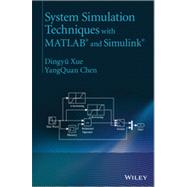This book begins with covering the fundamentals of MATLAB programming and applications, and the solutions to different mathematical problems in simulation. The fundamentals of Simulink modelling and simulation are then presented, followed by coverage of intermediate level modelling skills and more advanced techniques in Simulink modelling and applications.
Finally the modelling and simulation of engineering and non-engineering systems are presented. The areas covered include electrical, electronic systems, mechanical systems, pharmacokinetic systems, video and image processing systems and discrete event systems. Hardware-in-the-loop simulation and real-time application are also discussed.
Key features:
- Progressive building of simulation skills using Simulink, from basics through to advanced levels, with illustrations and examples
- Wide coverage of simulation topics of applications from engineering to non-engineering systems
- Dedicated chapter on hardware-in-the-loop simulation and real time control
- End of chapter exercises
- A companion website hosting a solution manual and powerpoint slides
System Simulation Techniques with MATLAB and Simulink is a suitable textbook for senior undergraduate/postgraduate courses covering modelling and simulation, and is also an ideal reference for researchers and practitioners in industry.








